
|
Sale 81
The Pre-Long Beach Sale
| Lot |
Photo |
Description |
Realized |
Lot 1230 |
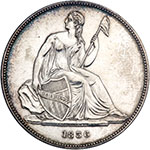 |
1836 Pattern Dollar. Silver, Plain Edge. Judd-60 Rarity 1. Pollock-65. PCGS graded Proof 61. Original, Coin Alignment. Some scattered faint hairlines, none of which are worthy of mention. Lightly toned.
In December, 1836, the United States Mint at Philadelphia struck 1,000 Gobrecht Dollars for circulation. The coins weigh 416 grains, which continued the standard as enacted in the Coinage Act of 1792. These historic pieces are dated 1836 with C. GOBRECHT F. (F is an abbreviation for the Latin word Fecit, or "made it", and is found on the base of the rock on which Liberty is seated). Most are struck with the traditional "coin" turn. They clearly entered circulation, even though struck as Proofs, since many are found in worn condition today. High grade examples like this attractive Proof 61 are scarce and sought after. Since quite a few are found damaged, and this one is free from injury, we give it a double thumbs-up for any serious buyer who consider owning an example. Many believe these handsome coins to be the most desirable Gobrecht-designed pieces of them all, and are very rare for a circulation strike Proof quality United States coin.
Pop 22; 70 finer, 34 in 62, 1 in 62+, 22 in 63, 13 in 64 (PCGS # 11225) .
Historic Note: According to numismatic researcher, Jeff Garrett, "American silver dollars were first struck in 1794, having been authorized by an act of Congress on April 2, 1792. Weight and fineness were specified at 416 grains and .8924 fine silver. The first type of silver dollar struck was the Flowing Hair issue of 1794 and 1795. A 1794 silver dollar recently made international headlines when it was old at auction for over $10 million dollars. Draped Bust Silver dollars were struck from 1795 to 1803. Mintage records for 1804 show that 19,570 silver dollars were struck that year. It was common practice in those days to use dies as long as they were serviceable, and it is likely that all silver dollars struck in 1804 were actually dated 1803. The famous silver dollars of 1804 were actually struck decades later for presentation purposes.
"The production of silver dollars was suspended in the United States starting in 1806. (President Thomas Jefferson's order to stop dollar production was in 1806, thus dollars were struck in 1804 and 1805!) The demand for American silver dollars was met in a large degree by the Spanish 8 reales, also called a piece of eight, the equivalent of the U.S. Dollar. These coins circulated in the United States widely and are often found along with American coinage in any shipwreck or hoard find of the period. In 1835 the Mint Director, R.M. Patterson, ordered engraver Christian Gobrecht to create dies based on the designs of Thomas Sulley and Titian Peale. After some experimentation, dies were created for the first issue of Gobrecht silver dollars. Gobrecht Silver dollars fall into three basic categories - Circulation and Original Issues, Patterns and finally Restrikes. The coins are also struck in either a coin turn orientation or a medal turn orientation. This means that when the coin is turned over the eagle is either right side up (coin turn orientation) or upside down (medal turn orientation). To further complicate matters, Gobrecht silver dollars are found with two basic die alignments. The die alignment means that when the coin is turned over, the eagle is either flying upward or level.".
Estimated Value $20,000 - 22,000.
View details and enlarged photos
Check results on similar lots
| Unsold |
Lot 1231 |
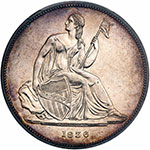 |
1836 Pattern Dollar. Silver, plain edge, original, coin alignment. Judd-60, Pollock-65, Rarity 1. PCGS graded Proof 58. Fully brilliant with nice light gold toning. One of the 1,000 coins struck in December 1836 and single out by the coin orientation of the obverse and reverse with the eagle flying "onward and upward." This is an enjoyable, high grade pattern that is toned in a relaxed manner, not heavily tarnished as some, and displays a virtual absence of marks and blemishes that could be deemed troubling. One of the finer original AU58 strikings we have seen in recent sales and certain to appeal to Type buyers. Pop 27; 103 finer at PCGS. (PCGS # 11225) .
Estimated Value $15,000 - 17,000.
View details and enlarged photos
Check results on similar lots
| Realized
$17,625 |
Lot 1232 |
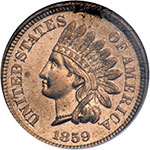 |
1859 Pattern Cent. Copper-nickel, plain edge. Judd-228. Pollock-272. Rarity 1. NGC graded MS-64. Lots of mint luster. A perennial favorite. Because this issue was struck on a coining press and in relatively large numbers for a Pattern, many collectors of Indian Cents buy one for their regular collection as sort of a transition coin. J-228 incorporates the regular obverse of 1859 with the shield-and-wreath reverse introduced in 1860. Pop 39; 50 finer, 42 in 65, 1 in 65+, 7 in 66. (PCGS # 11932) .
Estimated Value $1,100 - 1,200.
View details and enlarged photos
Check results on similar lots
| Realized
$4,935 |
Lot 1233 |
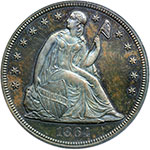 |
1864 Pattern Dollar. Copper, reeded edge. Judd-397. Pollock-465. Low Rarity 7. PCGS graded Proof 65 Brown. CAC Approved. Lovely green and golden toning. The regular issue obverse for the 1864 Seated Liberty dollar is combined with the regular issue With Motto Seated Liberty reverse, struck with Proof dies; struck in aluminum with a reeded edge. This is an extremely rare Pattern Seated Dollar issue with possibly as few as four examples known. It is a splendid Gem Brown Proof that displays excellent cameo contrast. The mirrored surface has pleasing medium aquamarine to blue and brown iridescence. Although often cataloged or offered as Transitional issues, it is now believed that these Pattern pieces were actually made in the late 1860s or early 1870s at the Mint for sale to collectors. Pop 1; 1 finer in 66. (PCGS # 60568) .
Estimated Value $15,000 - 17,000.
Ex Samuel Berngard Collection.
View details and enlarged photos
Check results on similar lots
| Unsold |
Lot 1234 |
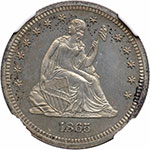 |
1865 Pattern Quarter Dollar. Silver, reeded edge. Judd-425. Pollock-497. High Rarity 6. NGC graded Proof 65 Cameo. Hint of light gold tone. With motto transitional. Pop 1; none finer at NGC. The only example graded as Proof Cameo by NGC.
Historic Note: It was long assumed that all of these "In God We Trust" Patterns were truly struck in the same years they were dated, but as research evolved, it was generally concluded that the 1863 and 1864 dated pieces were probably struck in later years, perhaps in 1868 or 1869 by mint employees for sale to collectors. Die characteristics and die rust on the reverses of the 1863 and 1864 Quarters tend to reinforce this conclusion. However it was still widely believed that those dated 1865 actually were from 1865. In fact the 1949 Red Book even included the 1865 "In God We Trust" Half Dollar as a regular issue.
Then in 1977 one of these 1865 transitionals, an 1865 "In God We Trust" Dollar (listed as Judd no. 434 in one of the standard Pattern references, United States Pattern, Experimental and Trial Pieces by J. Hewitt Judd) appeared in the Fairfield Collection sale. This cataloguer, who was working for Bowers & Ruddy then, was the one who first called attention to the fact the coin was overstruck on an 1866 dollar! The coin was bought by Harry Bass Jr. and today resides in the Bass museum at the ANA in Colorado Springs. The eminent numismatic scholar Walter Breen summarized the impact of this discovery in his Complete Encyclopedia of U.S. and Colonial Coins published in 1988:
"For generations the silver and gold coins (of 1865) were accepted as true transitional issues. but in recent years their status has been flung into doubt because of a single silver dollar dated 1865 with motto, over struck on another dollar dated 1866."
Estimated Value $6,000 - 6,500.
View details and enlarged photos
| Realized
$7,050 |
Lot 1235 |
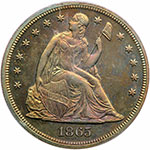 |
1865 Pattern Dollar. Copper, reeded edge. Judd-435. Pollock-508. Low Rarity 7. PCGS graded Proof 66 Brown. Lovely shades of rainbow toning on both sides supported by light pinkish lilac tones. The obverse die is the same as that of the regular issue 1865 Seated Liberty Dollar, while the reverse is that of the regular issue 1866 and 1867 Seated Dollars with the motto IN GOD WE TRUST on a scroll over the eagle. Struck in copper with a reeded edge. This important transitional Pattern is similar in rarity to its Judd-434 silver alloy counterpart. A bold and carefully struck Gem with dominating pastel shaded colors, although the fields and highpoints offer gentle reflective qualities from the near-pristine mirror surfaces. A few nearly invisible hairlines in the field and nowhere do we find any marks or spots.Pop 1; none finer at PCGS. (PCGS # 60620) .
Note: Patterns with the motto IN GOD WE TRUST on the reverse were struck not only for the silver set of quarter dollar, half dollar and dollar, but also for the gold set of half eagle, eagle and double eagle.
Estimated Value $17,000 - 19,000.
View details and enlarged photos
Check results on similar lots
| Unsold |
Lot 1236 |
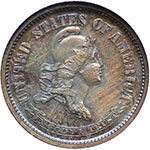 |
1869 Pattern Dime. MINT ERROR. Copper, reeded edge. Judd-698. Pollock-777. Low Rarity 7. Double struck with obverse rotation. NGC graded MINT ERROR Proof 64 Brown. Attractive reddish iridescent colors adds to its appeal.
Estimated Value $900 - 1,000.
View details and enlarged photos
| Realized
$1,880 |
Lot 1237 |
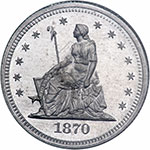 |
1870 Pattern Quarter Dollar. Aluminum, reeded edge. Judd-886. Pollock-985. High Rarity 7. PCGS graded MS-65. CAC Approved. A shimmering aluminum bright coin. Stark glowing fields swirl with luster causing the mint brilliance to dart across the surface in all directions, seeking an escape from the confines of the rims. In addition, the coin possesses a nice, clear-cut strike for all areas with outstanding detail at the stars, William Barber's petite Liberty (who in this rendition is seated facing left instead of right as on the regular issue coins). The eagle side, meaning the reverse, is from the regular Proof With Motto dies this year, and struck with the same exactitude as every US Proof of 1870 coin, as well as the same crispness as on the obverse. In short, the devices show an incredible bold strike. Pop 1; 1 finer in 66.
Estimated Value $9,000 - 9,500.
Ex Simpson Collection.
View details and enlarged photos
| Unsold |
Lot 1238 |
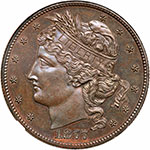 |
1877 Pattern Half Dollar. Copper, reeded edge. Judd-1525. Pollock-1691. Low Rarity 7. NGC graded Proof 67 Brown. Lovely brown colors. The central figure of the obverse is a bust of Liberty facing left. Liberty wears a cap with a wide band, and her hair is confined by a ribbon. The band of the cap is inscribed LIBERTY and is adorned with wheat and cotton. An array of 13 stars surrounds the bust, and the date is below. The reverse features an eagle, displayed on a shield, clutching an olive branch and three arrows. A circular band is visible behind the shield, with the Gothic inscriptions "In God We trust" and "e pluribus unum." The peripheral inscriptions are UNITED STATES OF AMERICA and HALF DOLLAR. Struck in copper with a reeded edge.
From the FUN 2009 Commentary. "Barber's distinctive obverse design was later used on the Goloid pattern dollars of 1878-1880. There are two varieties of Judd-1525, which Andrew Pollock designated as Pollock-1691 and 1693. The present coin is an example of the former designation, characterized by the second 7 in the date being distant from the dentils. USpatterns.com currently traces eight examples of Pollock-1691 (see the website for detailed census information). The coin offered here is a virtually unimprovable specimen, off the market since 1971. Advanced pattern collectors should be prepared for stiff competition when this lot comes up for bidding.
"A beautiful array of mint red, crimson, olive, and light blue toning makes this coin a visual treat. All elements of the intricate design are finely detailed and complement the flawless surfaces to produce fantastic eye appeal. The present coin is the finest certified example in the Brown category at both NGC and PCGS." Pop 1; none finer at NGC.
Note: More Patterns were made in 1877 than in any other year. Most numerous are the rare Pattern half dollars which form one of the most beautiful and interesting series of all. They include designs by Anthony C. Paquet, William Barber and George T. Morgan. Judd-1525 is by the Mint's chief engraver, Barber. William Barber (born in London in 1807), became chief engraver at the Philadelphia Mint following the death on January 1, 1869, of James B. Longacre, who had held the post since 1844. He produced many dies for Pattern coins during the decade of the 1870s, most notably a large oeuvre of 20-cent pieces 1874-1875, commercial dollars and trade dollars 1873-1876, the handsome half dollars of 1877, and silver dollars 1878-1879, among numerous others. His work varies from the ordinary to the inspired, perhaps his 1872 Amazonian silver coins representing his most acclaimed accomplishment in the latter category. For several years after Longacre's death, Barber used Longacre hubs and models to create new varieties of Seated Liberty motifs, later making his own version (which seemed to fall short of Longacre's work). Important to the study of Patterns, William Barber was front row center during the most pivotal era of Pattern issuance in American history, during the regime of Henry Linderman, during the making and/or distribution of restrikes, irrelevant mulings, etc. No doubt, if he had written his numismatic biography, many secrets would have been revealed. Today, the Pattern field is richly endowed with his work.
Estimated Value $24,000 - 26,000.
Ex: Public Auction Sale (Lester Merkin, 9/1967), lot 542; Public Auction Sale (Lester Merkin, 6/1971), lot 887; Heritage FUN 1/2009.
View details and enlarged photos
| Unsold |
|
|